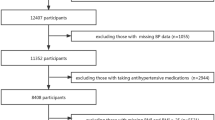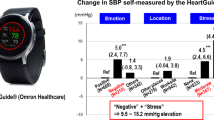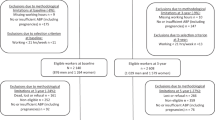Abstract
The underlying pathogenetic mechanisms of nondipping blood pressure (BP) pattern are not completely understood. Especially the role of psychosocial correlates remains unclear. The aim was to assess the association between nondipping BP pattern, behavioural and psychosocial factors in a sample of working men and women. The study sample included 167 working men and women aged 40–64 years from the BELSTRESS cohort. Socio-demographic, behavioural and psychosocial factors were assessed by self-administered questionnaires. Participants were medically examined and underwent an ambulatory BP monitoring during 24 h. Nondipping was defined when the average nocturnal decline in BP was <10%. The prevalence of nondipping for both systolic and diastolic BP was 7.8%. Nondipping was not significantly related to smoking, alcohol consumption and leisure time physical activity. A crude significant association was observed between nondipping and sleep problems. After adjusting for gender, education and body mass index, the risk for nondipping was associated with job strain, living alone, being unsatisfied about the contact with one's children, depressive symptoms and vital exhaustion. Nondipping BP pattern was consistently related to psychosocial factors in this study: positive associations were observed with measures of job strain, poor private life support (living alone and being unsatisfied about the contact with one's children) and mental health problems (depressive symptoms and vital exhaustion).
This is a preview of subscription content, access via your institution
Access options
Subscribe to this journal
Receive 12 digital issues and online access to articles
$119.00 per year
only $9.92 per issue
Buy this article
- Purchase on Springer Link
- Instant access to full article PDF
Prices may be subject to local taxes which are calculated during checkout
Similar content being viewed by others
References
White WB . Importance of blood pressure control over a 24-h period. J Manag Care Pharm 2007; 13: 34–39.
O’Brien E, Sheridan J, O’Malley K . Dippers and non-dippers. Lancet 1988; 2: 397.
Bouhanick B, Chamontin B . Should pulse pressure and day/night variations in blood pressure be seen as independent risk factors requiring correction or simply as markers to be taken into account when evaluating overall vascular risk? Diabetes Metab 2007; 33: 321–330.
de la Sierra A, Redon J, Banegas JR, Segura J, Parati G, Gorostidi M et al. Prevalence and factors associated with circadian blood pressure patterns in hypertensive patients. Hypertension 2009; 53: 466–472.
Fagard RH, Thijs L, Staessen JA, Clement DL, De Buyzere ML, De Bacquer DA . Night-day blood pressure ratio and dipping pattern as predictors of death and cardiovascular events in hypertension. J Hum Hypertens 2009; 23: 645–653.
Ohkubo T, Hozawa A, Yamaguchi J, Kikuya M, Ohmori K, Michimata M et al. Prognostic significance of the nocturnal decline in blood pressure in individuals with and without high 24-h blood pressure: the Ohasama study. J Hypertens 2002; 20: 2183–2189.
Redon J, Lurbe E . Nocturnal blood pressure versus nondipping pattern: what do they mean? Hypertension 2008; 51: 41–42.
Routledge F, Fetridge-Durdle J . Nondipping blood pressure patterns among individuals with essential hypertension: a review of the literature. Eur J Cardiovasc Nurs 2007; 6: 9–26.
Kanbay M, Turgut F, Uyar ME, Akcay A, Covic A . Causes and mechanisms of nondipping hypertension. Clin Exp Hypertens 2008; 30: 585–597.
Rodriguez CJ, Burg MM, Meng J, Pickering TG, Jin Z, Sacco RL et al. Effect of social support on nocturnal blood pressure dipping. Psychosom Med 2008; 70: 7–12.
Linden W, Klassen K, Phillips M . Can psychological factors account for a lack of nocturnal blood pressure dipping? Ann Behav Med 2008; 36: 253–258.
Mellman TA, Brown DD, Jenifer ES, Hipolito MM, Randall OS . Posttraumatic stress disorder and nocturnal blood pressure dipping in young adult African Americans. Psychosom Med 2009; 71: 627–630.
Routledge FS, Fetridge-Durdle JA, Dean CR . Stress, menopausal status and nocturnal blood pressure dipping patterns among hypertensive women. Can J Cardiol 2009; 25: e157–e163.
Afsar B, Elsurer R, Sezer S, Ozdemir FN . Nondipping phenomenon and quality of life: are they related in essential hypertensive patients? Clin Exp Hypertens 2010; 32: 105–112.
Mezick EJ, Matthews KA, Hall M, Kamarck TW, Strollo PJ, Buysse DJ et al. Low life purpose and high hostility are related to an attenuated decline in nocturnal blood pressure. Health Psychol 2010; 29: 196–204.
Clays E, De Bacquer D, Leynen F, Kornitzer M, Kittel F, De Backer G . Long-term changes in the perception of job characteristics: results from the Belstress II--study. J Occup Health 2006; 48: 339–346.
Clays E, Leynen F, De Bacquer D, Kornitzer M, Kittel F, Karasek R et al. High job strain and ambulatory blood pressure in middle-aged men and women from the Belgian job stress study. J Occup Environ Med 2007; 49: 360–367.
Yamasaki F, Schwartz JE, Gerber LM, Warren K, Pickering TG . Impact of shift work and race/ethnicity on the diurnal rhythm of blood pressure and catecholamines. Hypertension 1998; 32: 417–423.
ILO. International Standard Classification of Occupations: ISCO-88. International Labour Office: Geneva, 1990.
Karasek R, Brisson C, Kawakami N, Houtman I, Bongers P, Amick B . The Job Content Questionnaire (JCQ): an instrument for internationally comparative assessments of psychosocial job characteristics. J Occup Health Psychol 1998; 3: 322–355.
Pelfrene E, Vlerick P, Mak R, De Smet P, De Backer G, Kornitzer M . Scale reliability and validity of the Karasek ‘job demand-control-support’ model in the Belstress-study. Work Stress 2001; 15: 297–313.
Kohout F, Berkman L, Evans D, Cornoni-Huntley J . Two shorter forms of the CES-D depression symptoms index. J Aging Health 1993; 5: 179–193.
Clays E, De Bacquer D, Leynen F, Kornitzer M, Kittel F, De Backer G . Job stress and depression symptoms in middle-aged workers--prospective results from the Belstress study. Scand J Work Environ Health 2007; 33: 252–259.
Stepnowsky Jr CJ, Nelesen RA, DeJardin D, Dimsdale JE . Socioeconomic status is associated with nocturnal blood pressure dipping. Psychosom Med 2004; 66: 651–655.
Kotsis V, Stabouli S, Bouldin M, Low A, Toumanidis S, Zakopoulos N . Impact of obesity on 24-h ambulatory blood pressure and hypertension. Hypertension 2005; 45: 602–607.
Cuspidi C, Meani S, Valerio C, Negri F, Sala C, Maisaidi M et al. Body mass index, nocturnal fall in blood pressure and organ damage in untreated essential hypertensive patients. Blood Press Monit 2008; 13: 318–324.
Borel AL, Benhamou PY, Baguet JP, Debaty I, Levy P, Pepin JL et al. Short sleep duration is associated with a blood pressure nondipping pattern in type 1 diabetes: the DIAPASOM study. Diabetes Care 2009; 32: 1713–1715.
Friedman O, Shukla Y, Logan AG . Relationship between self-reported sleep duration and changes in circadian blood pressure. Am J Hypertens 2009; 22: 1205–1211.
Matthews KA, Kamarck TW, Hall H, Strollo PJ, Owens JF, Buysse DJ et al. Blood pressure dipping and sleep disturbance in African-American and Caucasian men and women. Am J Hypertens 2008; 21: 826–831.
Fallo F, Barzon L, Rabbia F, Navarrini C, Conterno A, Veglio F et al. Circadian blood pressure patterns and life stress. Psychother Psychosom 2002; 71: 350–356.
Cuspidi C, Meani S, Valerio C, Sala C, Fusi V, Masaidi M et al. Reproducibility of dipping/nondipping pattern in untreated essential hypertensive patients: impact of sex and age. Blood Press Monit 2007; 12: 101–106.
Sjolin-Israelsson BA, Enstrom IE . The impact of work on the night blood pressure dipping profile. Blood Press 2007; 16: 45–49.
Henskens LH, Kroon AA, van Oostenbrugge RJ, Haest RJ, Lodder J, de Leeuw PW . Different classifications of nocturnal blood pressure dipping affect the prevalence of dippers and nondippers and the relation with target-organ damage. J Hypertens 2008; 26: 691–698.
Acknowledgements
This study was supported by Belgian Federal Public Service Employment, Labour and Social Dialogue and European Social Fund.
Author information
Authors and Affiliations
Corresponding author
Ethics declarations
Competing interests
The authors declare no conflict of interest.
Rights and permissions
About this article
Cite this article
Clays, E., Van Herck, K., De Buyzere, M. et al. Behavioural and psychosocial correlates of nondipping blood pressure pattern among middle-aged men and women at work. J Hum Hypertens 26, 381–387 (2012). https://doi.org/10.1038/jhh.2011.42
Received:
Revised:
Accepted:
Published:
Issue Date:
DOI: https://doi.org/10.1038/jhh.2011.42
Keywords
This article is cited by
-
Napping on the night shift and its impact on blood pressure and heart rate variability among emergency medical services workers: study protocol for a randomized crossover trial
Trials (2021)
-
The relation of work-related factors with ambulatory blood pressure and nocturnal blood pressure dipping among aging workers
International Archives of Occupational and Environmental Health (2020)
-
Functional capacity and heart rate response: associations with nocturnal hypertension
BMC Cardiovascular Disorders (2015)
-
Non-dipping nocturnal blood pressure and psychosis parameters in Parkinson disease
Clinical Autonomic Research (2015)
-
Cardiorespiratory fitness, cardiovascular workload and risk factors among cleaners; a cluster randomized worksite intervention
BMC Public Health (2012)



